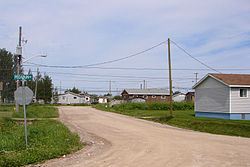- Moose Cree First Nation
-
Coordinates: 51°15′43″N 80°36′02″W / 51.261951°N 80.600674°W
The Moose Cree First Nation (formerly known as Moose Factory Band of Indians) is a Cree First Nation in northern Ontario, Canada. Since time immemorial, their traditional territory is on the west side of James Bay. The nation has two reserves: Factory Island 1 (the northern two-thirds of Moose Factory Island); and Moose Factory 68, a tract of land about 15 km upstream on the Moose River covering 168.82 square kilometres (65.18 sq mi).[1]
History
The Cree were a peaceful nation who, for most of the year, would travel to and from harvesting areas, living off the land. During the summer months they traveled on the waterways by canoe: harvesting and preserving fish, berries and other food staples. Bountiful waterfowl was harvested during the fall months along the shores of the James Bay. Prior to the arrival of harsh winter months the families made their way to their wintering grounds where they will harvest big game and fur bearing animals. Just prior to the spring thaw, the Cree families hunted waterfowl as they migrated north. Thus was the annual cycle of the swampy Cree.
The early exposure to the European society had drastically influenced the lifestyle of the local inhabitants of the area. A fur trading post was "established" in Moose Factory area in 1673 by the Hudson's Bay Company. As a result, the Cree began to congregate in and around the fur trade post and became deeply exposed to European lifestyle. Today, Moose Factory holds the "distinction" of being Ontario's oldest English speaking settlement.
In 1905, on behalf of the King of England, Treaty Commissioners, "negotiated" a treaty with Moose Cree First Nation. Treaty #9 was signed on the ninth day of August 1905. To view the contents of Treaty No 9 go to: [1] Two tracts of land were subsequently set aside for use and "benefit" of Moose Cree First Nation members. Moose Factory Indian reserve #1 is located on the Moose Factory Island. It occupied approximately two thirds of the island. The second tract of land, namely, Moose Factory Indian reserve #68 is located approximately 10 miles south from Moose Factory at the mouth of the French River.
The name "Moose Factory" is derived from its location on the Moose River as well as from the fur trade era of the Hudson's Bay Company. The officer in charge of the fur trading post was referred to as the "factor". Another account is that the name originates from the name of the river and a furniture factory that was once located within the community.[2]
References
- ^ "Moose Cree First Nation". Aboriginal Community in Canada. Indian and Northern Affairs Canada. http://www.aboriginalcanada.gc.ca/acp/community/site.nsf/eng/fn144.html. Retrieved 2010-12-17.
- ^ http://www.moosecree.com/our_community/history.html
External links
- Indian and Northern Affairs Canada: First Nation Detail
- The Moose Cree First Nation Website
- Moose Cree Education Authority
Nishnawbe Aski Nation Independent First Nations Alliance Keewaytinook Okimakanak Council Matawa First Nations Aroland • Constance Lake • Eabametoong • Ginoogaming • Hornepayne • Long Lake 58 • Marten Falls • Neskantaga • Nibinamik • Webequie
Mushkegowuk Council Attawapiskat • Chapleau Cree • Fort Albany • Kashechewan • Missanabie Cree • Moose Cree • Taykwa Tagamou • Weenusk
Shibogama First Nations Council Wabun Tribal Council Beaverhouse • Brunswick House • Chapleau Ojibway • Flying Post • Matachewan • Mattagami • Wahgoshig
Windigo First Nations Council Bearskin Lake • Cat Lake • Koocheching • North Caribou Lake (Weagamow Lake) • Sachigo Lake • Slate Falls • Whitewater
independent NAN communities Mishkeegogamang • Mocreebec Council • Sandy Lake
Categories:- Nishnawbe Aski Nation
- First Nations governments in Ontario
- Cree nations
Wikimedia Foundation. 2010.

